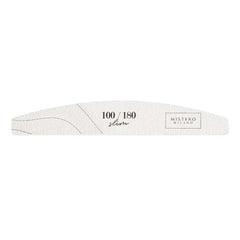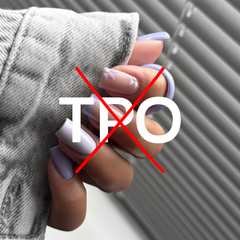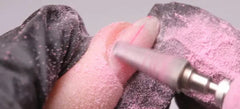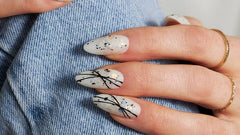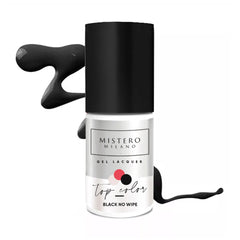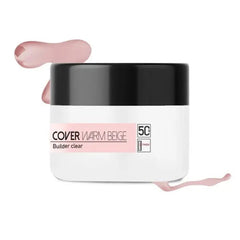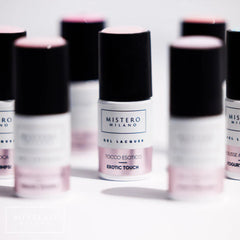Files
Amber D'Halluin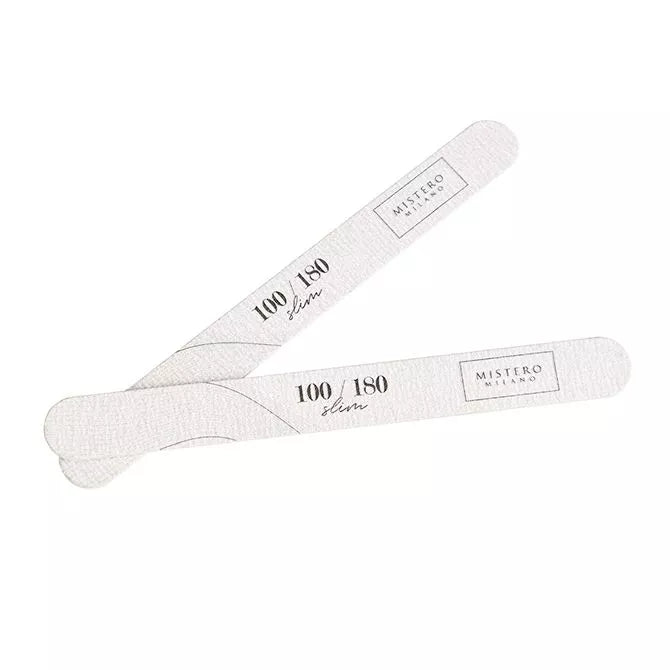
1. What is the grit of a nail file
Every nail file has numbers, but what do those numbers mean? The numbers refer to the grit of the nail file, or the size and coarseness of the abrasive particles on the file. When both numbers are the same, it means that both sides of the file have the same grit. If the numbers are different, each side of the file has a different grit and function.
A file with grit 180/180 means that both sides have a grit of 180. A file with grit 100/180 means that one side has a coarser grit than the other side.
In general, the lower the grit number, the coarser the grit, and the higher the number, the finer the grit. Understanding how grit works on a file can help you determine which file is best suited to your needs. Below is a detailed explanation of the different grades and their applications.
1.1. Grades and operation of the regular files
A regular nail file is ideal for touching up or removing artificial nails. To prepare the natural nail plate, we recommend using a nail file with a grit of 240. Although some nail stylists also use grit 180, we do not recommend this. Lower grits cause deeper and wider scratches on the nail plate. This increases the risk of damage, because with a coarser grit the nail plate is quickly filed too thin. Below we give an overview of different grits and their functions.
- Grit 80 is used for shaping and removing acrylic nails (only to be used on a hard mass). Note: never use this grit on your natural nail plate, as this can cause damage.
- Grit 100 is used for filing artificial nails into shape and removing them. Note : never use this grit on your natural nail plate, as this can cause damage.
- Grit 180 is used for filing both your natural nail plate and artificial nails to file them into the desired shape. In addition, it can also be used to shorten your nails.
- Grit 240 is used to mattify your natural nail plate and prepare it for the next steps in the manicure. For matting your nail plate, we recommend a buffer file.
1.2. Gradations and operation of buffer files and block files
Both buffer files and block files have similar functions. Which one is best depends on your personal experience and preferences. Some people prefer a buffer file, while others prefer a block file. We will explain the different grades and their application in more detail. buffer files and block files .
- Grit 100 is used to even out the entire surface of your artificial nail and to remove deep scratches.
- Grit 120 is used to mattify and smooth the natural nail plate.
- Grit 180 is used to remove scratches on artificial nails and to mattify and smooth the natural nail plate.
- Grit 240 is used to mattify and smooth the natural nail plate.
- Grit 280 is used to remove scratches on artificial nails and to mattify natural nails.
1.3. Gradations and operation of the polishing file
A classic manicure often involves a polishing file used to give nails a beautiful natural shine, without the need for nail polish. Below you will find more explanation about the different grit sizes and the operation of polishing files.
- Grit 600 is used to mattify the natural nail plate.
- Grit 3000 is used to make the natural nail plate shine.
2. What is the difference between a buffer file and a regular file?
There are many differences between a regular nail file and a buffer file. Each is used for different purposes: the nail file is used to file the nails, while the buffer file is used to polish the nails. Moreover, these files are made in a specific way, which gives them their own unique properties.
A nail file has a hard core, with which the free edge of the nails is filed and the natural shape. In addition, regular files are sometimes used to shorten the nails instead of nail clippers or nail scissors.
A buffer file, on the other hand, has a soft core that offers more flexibility. This file is used to smooth the surface of the nails, even out ridges and give the nails a shiny and healthy look. In addition, a nail buffer can be used to matt the natural nail plate, which ensures better adhesion of nail products.
3. What is the difference between the different file shapes?
There are various shapes of nail files available on the market. Many people wonder if the shape of the file is important. The answer is yes, each shape has its own function. Below you will find an overview of the different shapes and their specific function.
-
Banana file
The banana file is perfect for filing nails around the cuticles. In addition, this file has an ergonomic shape that prevents wrist strain. - Straight file
The straight file is ideal for filing the sidewalls and tips of your nails straight. - Crescent
The half-moon file combines the properties of a straight and a banana file. With this file you can file precisely along the nail walls and around the cuticles. - Oval
The oval file has a rounded side on both ends. This file is perfect for filing the bottom of the nail and around the cuticles. In addition, the oval file is wider, allowing you to file a larger surface of the nail.

4. Which nail file is used to remove gel, acrylic gel and acrylic?
When removing gel, acrylic gel or acrylic nails, it is recommended to choose a file with a grit between 80 and 180. Often a 100/180 or 80/100 file used.
Grit 80 is used to reduce the thickness of the nail product and grit 100 is used to shorten the artificial nails. Please note that you should never use grit 80 and 100 on your natural nails as this can cause damage to your natural nail plate.
5. Which nail file is used to remove gel polish?
When removing gel polish, it is recommended to choose a file with a grit between 100 and 180. Often a 100/180 or 180/240 file used.
Grit 100 is used to reduce the thickness of the nail product and shorten your artificial nails and grit 180 is used to shape your natural nail. Please note that you should never use grit 100 on your natural nails as this can damage your natural nail plate.
6. Which grit can I use on natural nails?
When filing your natural nail plate, it is recommended to choose a file with a grit between 180 and 240. Often a 100/180 or 180/240 file used.
Although professional nail technicians often use a grit 180 for filing the surface of natural nails, it is recommended not to use a file with a grit larger than 240. Grit 180 can still be used to shorten and shape your natural nails. Buffer files can have a coarse grit, however, because they have a cushioning layer that offers more protection.




